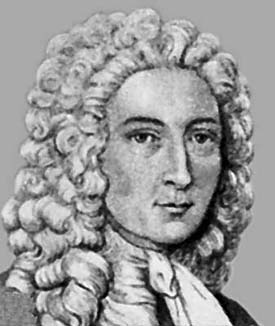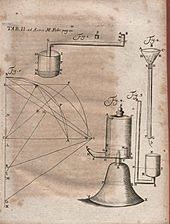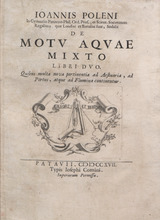Giovanni Poleni facts for kids
Quick facts for kids
Giovanni Poleni
|
|
|---|---|
 |
|
| Born | August 23, 1683 |
| Died | 15 November 1761 (aged 78) |
| Resting place | Basilica del Carmine, Padua |
| Occupation | Physicist, mathematician and antiquarian |
| Spouse(s) | Orsola Roberti |
| Children | 6 |
| Parent(s) | Giacomo Poleni and Isabella Poleni (née de' Brugnol) |
| Scientific career | |
| Institutions | University of Padua |
Giovanni Poleni was a very smart Italian man. He was born on August 23, 1683, and passed away on November 15, 1761. He was a physicist, a mathematician, and someone who studied old things (an antiquarian). He was also a Marquess, which is a type of noble title.
Contents
Giovanni Poleni's Early Life
Giovanni grew up in Venice, Italy. His father was Marquess Jacopo Poleni. Giovanni went to school at the Somaschi Fathers in Venice. There, he learned many subjects. These included old writings, philosophy, religion, mathematics, and physics.
Giovanni Poleni's Career and Discoveries
Becoming a Professor
When Giovanni Poleni was 25 years old, he became a professor. He taught astronomy at the University of Padua. In 1715, he started teaching physics. A few years later, in 1719, he took over from Nicholas II Bernoulli as the mathematics professor.
Helping with Waterways
Poleni was an expert in hydraulic engineering. This means he knew a lot about how water moves and how to control it. The government in Venice asked him to manage the rivers in a region called lower Lombardy. He helped build things to stop floods. He was also often asked to solve problems between different states. These problems were usually about rivers that flowed between their lands.
Building a Calculator
In 1709, Poleni built a special calculator. It was the first one to use a "pinwheel" design. This calculator was made of wood. He called it his "calculating clock." Sadly, he destroyed it. He heard that another inventor, Anton Braun, got a lot of money for his own pinwheel machine.
Poleni wrote about his machine in a book called Miscellanea in 1709. Another person, Jacob Leupold, also described it in his book in 1727. In 1729, Poleni also made a device that could draw mathematical curves called logarithms.
Studying How Things Move
Poleni studied how falling objects hit surfaces. His ideas were similar to those of another scientist, Willem 's Gravesande. These studies led to a big discussion among scientists. It was part of a debate about "vis viva," which means "living force." This was an important topic in the early days of how we understand physics and motion.
Saving St. Peter's Dome
In 1748, the Pope, Benedict XIV, asked Poleni for help. The huge dome of St. Peter's Basilica in Rome was falling apart. Poleni went to Rome to examine it. He used a special method with a hanging chain to understand the dome's shape and weaknesses. He quickly figured out what repairs were needed to save the dome.
Other Achievements
Poleni also wrote many papers about ancient history and objects. In 1710, he became a member of the Royal Society in England. Later, he joined important science groups in France, Berlin, and St. Petersburg. The city of Padua honored him by building a statue of him. The city of Venice also made a special medal for him.
Poleni was married to Orsola Roberti.
Giovanni Poleni's Main Books
Poleni wrote several important books during his life:
- Miscellanea (about physics), published in Venice, 1709.
- De castellis per quæ derivantur fluviorum latera convergentia, published in Padua, 1720. This book was about how to manage rivers.
- Exercitationes Vitruvianæ, published in Venice, 1739.
- Il tempio di Diana di Efeso (The Temple of Diana at Ephesus), published in Venice, 1742. This book was about an ancient temple.
Images for kids






